Abstract
In ethno medicinal practices, the traditional healers use the genus Curcuma for the treatment of various ailments but Curcuma caesia Roxb. is a very less known and almost untouched drug. The present work attempts to establish the necessary pharmocognostic standards for evaluating the plant material of C. caesia Roxb. Various parameters, such as morphology, microscopy, physicochemical constants, and phytochemical profiles of the entire parts of the plant were studied and the salient diagnostic features are documented. Major chemical constituents, extractive values, physicochemical constants, and other features are also been recorded.
Keywords: Curcuma caesia Roxb., kali haldi, pharmacognostic, physicochemical constants, phytochemical profile, microscopy
INTRODUCTION
Curcuma caesia Roxb. is a member of the family Zingiberaceae and popularly known as Kali haldi. In India it is found in West Bengal, Madhya Pradesh, Orissa, Chhattisgarh, and Uttar Pradesh states. It flourishes well in moist deciduous forest areas.[1] Rhizomes of the plant are used for sprains and bruises and also employed in the preparation of cosmetics.[2] The effective use of Curcuma longa Linn. is well known since a long time; it is laxative, anthelmintic, and vulnerary, besides this it is used in blood disorders, leukoderma, scabies, small-pox, and sprains. Curcuma amada Roxb. is useful in bronchitis, asthma, sprains, skin diseases, and inflammation caused due to injuries. Curcuma aromatica Salisb. shows wound healing, anti-inflammatory, antiproliferative, and blood purifier activity. Curcuma zedoaria Christm. is said to be antimutagenic, anticarcinogenic, as well as anti-inflammatory. Curcuma angustifolia is an aphrodisiac and useful in the treatment of leprosy, asthma, anemia, and leukoderma. The inner part of rhizome is bluish black in color and emits a characteristic sweet smell. The “turkomans” (Turkish people) employ these roots as a rubeficient to rub the body after taking a Turkish bath. In Bengal, it is used in the fresh state–turmeric.[3] The plant is regarded as very auspicious and it is often used in India for various magic remedies. The rhizomes of the herb are often used by the Baiga, Sahariya, Agariya, Gond, Korku, and other tribal community of Mandla, Balaghat, Chhindwara, Anooppur, and Dindori district of Madhya Pradesh state for the treatment of pneumonia, cough, and cold in children, and for fever and asthma in adults. The powder of herb is used by tribal women as a face-pack during their engagement and marriage period.[4] Due to its increasing demand and overexploitation without ensuring its regeneration, the plant has recently been categorized as an endangered species, the plant is also having some amount of antifungal protein against drug-resistant Candida albicans.[5] The preliminary mechanistic studies have shown its smooth muscle relaxant activity on hydro alcoholic extract.[6]
According to some literatures, various other species of Curcuma are sold under the name of C. caesia and no scientific parameters are available to identify the true plant material and ensure its quality. Therefore, the present work has been performed to establish the various pharmacognostical and phytochemical parameters, which could serve as a measure of authentication and quality control for commercial samples of crude drug. The detailed microscopy of various parts of the plant (leaf, rhizome, root, and powder) has also been studied and documented.
MATERIALS AND METHODS
Plant Material
The whole plant material of C. caesia Roxb. was collected in the month of February 2008 from the forest region of Dindori district of Madhya Pradesh, India, and was authenticated on the basis of morphologic features in the botany department of Government Holkar Science College, Indore, Madhya Pradesh, India, by H.O.D. Dr. Sanjay Vyas. A voucher specimen (No. 413/03/2008) has been deposited in the department.
The fresh plant materials were taken and preserved in a mixture of solvent containing 70% alcohol for histological studies. Transverse sections (TS) were hand cut and stained with saffrinine and light green solutions. Microphotographs of the sections were made using Labomed CXR II microscope attached with canon coolpix digital camera.[7]
Physicochemical Constants
Physicochemical constants, such as the percentage of total ash, acid-insoluble ash, moisture content (on the basis of dry weight), loss on drying (LOD), water and alcohol soluble extractives, and volatile oil % were calculated as per the Indian pharmacopoeia.[8]
Phytochemical Screening
Preliminary phytochemical studies were carried out using 100 g powdered material and subjecting it to successive extraction in a Soxhlet apparatus with n-hexane, petroleum ether (60:80), benzene, chloroform, ethyl acetate, methanol, and water, the obtained extracts so were dried and weighed.[9,10] Various phytoconstituents, namely, carbohydrate (Molish's test), protein (Millon's test), fixed oils and fats (tincture alkana), steroids and terpenoids (Lieberman burchard test), alkaloids (Dragendroff's test), glycosides (Legal's test), tannins and phenols (ferric chloride test), and so on, were detected by standard chemical methods.[11,12]
Thin Layer Chromatography
Powdered drug 2 g was macerated with 10 mL of n-hexane for 24 h, extracted with methanol and the filtrate was evaporated under reduced pressure. The residue was dissolved in 5 mL of n-hexane and used for Thin Layer Chromatography (TLC) profile, while the standard solution was prepared by dissolving 10 mg of standard camphor (Sigma-Aldrich, Bangluru, India) in 10 mL of n-hexane. The samples were applied with the help of micropipette on precoated silica gel G60 F 254 TLC plates (Merck Ltd., Mumbai). The plates were developed using toluene:ethyl acetate:methanol (90:7:3) as solvent system and derivatized using anisaldehyde–sulphuric acid reagent.[13,14]
RESULTS
Macroscopy (Morphology of the Plant)
The plant is usually erect ranging from 0.5 to 1.0 m in height; it is differentiated into underground large ovoid tuberous rhizome often called root-stock and an erect aerial shoot with leaves and flowers [Figure 1].
Figure 1.
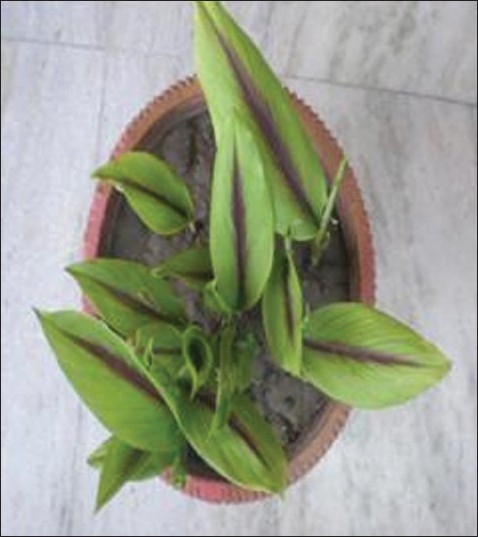
Curcuma caesia upper view
-
a)
Rhizome: The rhizome is tuberous with camphoraceous sweet odor, about 2–6 cm in diameter, the shape and size is often variable. It is sessile, laterally flattened, and covered with adventitious roots, root scars, and warts; moreover, it shows longitudinal circular wrinkles on the surface giving the look of nodal and internodal zones to the rhizome. The surface (cork) of rhizome is dark brown, bluish black, or buff in color; it shows circular arrangements of remnants of scaly leaves, which gives a false impression of growth rings. The branching is more or less sympodral [Figures 2 and 3].
-
b)
Root: As the plant propagates with rhizome, the primary roots are not noticed; however, yellow brown long fibrous and tapering adventitious roots are found all over the surface of rhizome [Figure 4]
-
c)
Leaves: The leaves are in the groups of 10–20, each leaf is broad oblong lanceolate and glabrous. In the middle region the lamina shows deep farraginous purple colored clouds. The petiole is ivory color and ensheathing the petioles encircle each other forming a pseudoaxis. The variation is parallel, typical characteristic of monocots [Figure 4].
-
d)
Inflorescence: It is 15-20 cm long dense spike, which arises much before the opening of leaf, the bracts are green, the bracts of coma are deep red, which become crimson when old [Figure 5].
-
e)
Flowers: Smaller than bracts, pale yellow with reddish border. Calyx: 10–15 mm long, obtuse, 3 toothed, and Corolla: long tubular, pale yellow lip – 3 lobed semi-elliptic [Figure 5].
Figure 2.
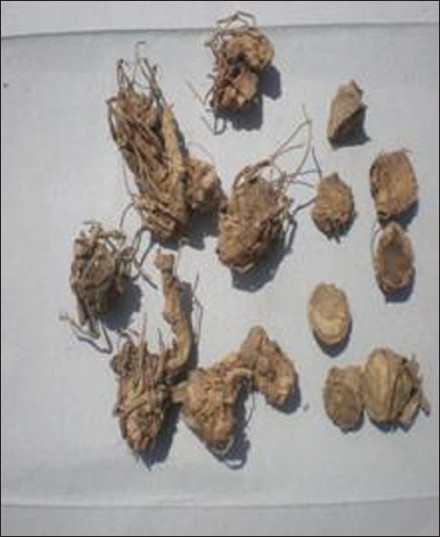
Dry rhizomes
Figure 3.
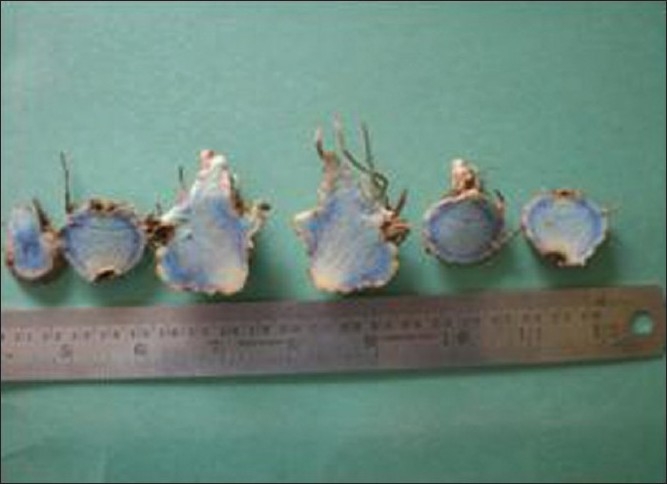
Freshly cut rhizomes of Curcuma caesia
Figure 4.
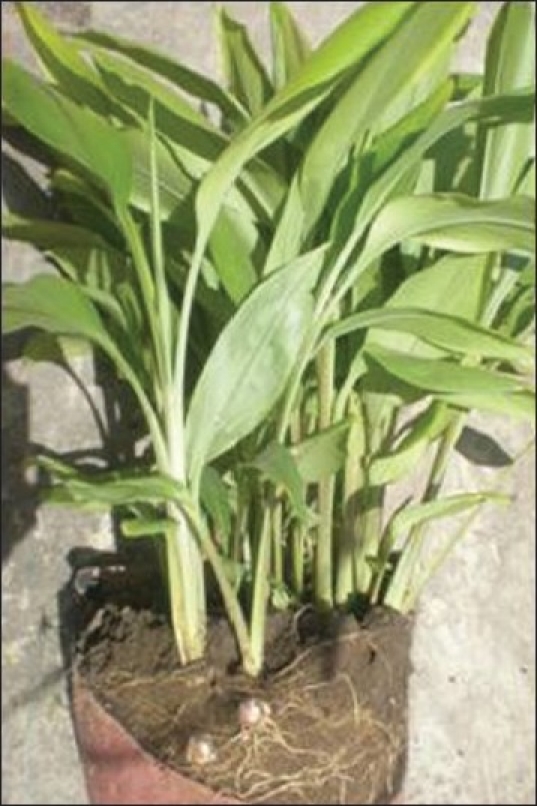
Whole plant
Figure 5.
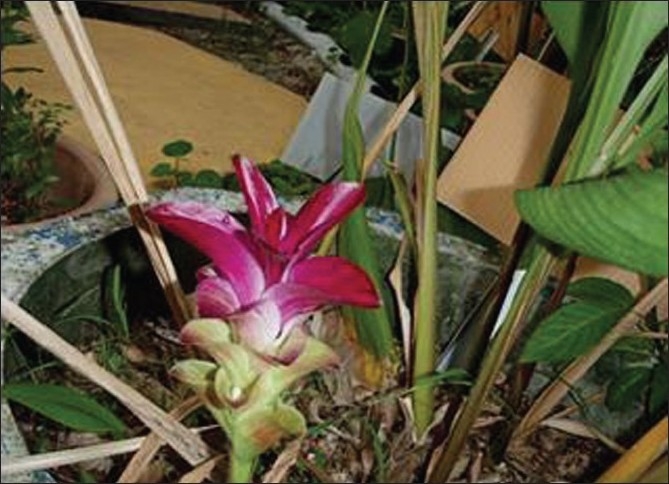
Curcuma caesia flower
Microscopy
Root: The TS of the adventitious root is circular in outline. It shows [Figures 6 and 7]
Figure 6.
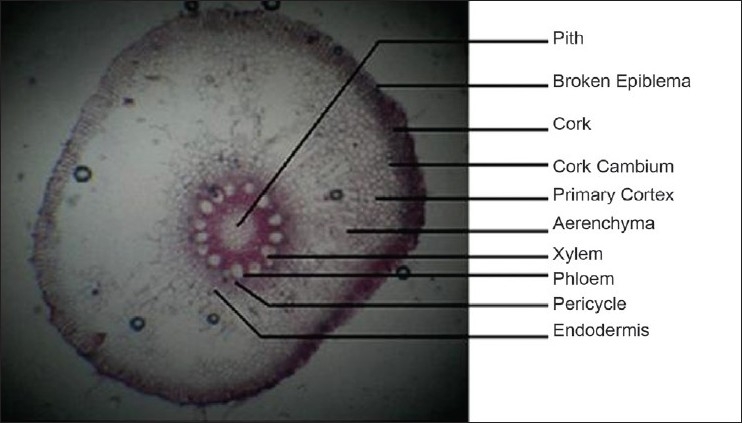
TS of adventitious root
Figure 7.
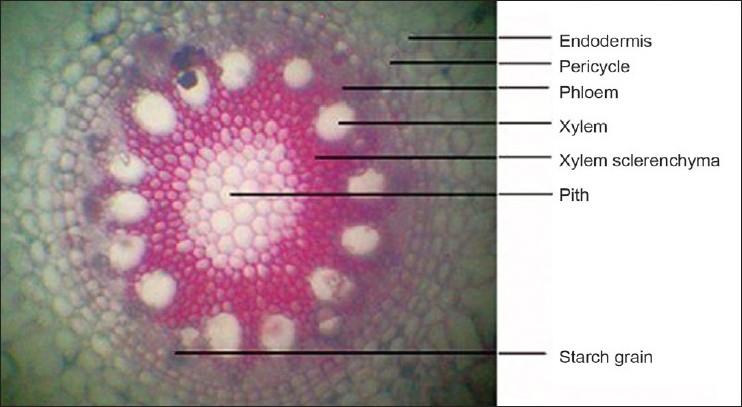
TS of root central part
Epiblema – Single layered. Consists of thick walled cutinized cells. In old specimen the epiblema is withered and is replaced by ten-layered rectangular cork cells
-
Cortex – Heterogeneous differentiated into
-
a)Outer cortex – Composed of parenchymatous tissue of secondary and primary cortex
-
b)Middle cortex – Made up of radially arranged air chambers separated by one cell thick partition wall – the trabaculae (a character of hygrophilous plant)
-
c)Endodermis – In the innermost layer of the cortex, the cells are rectangular and barrel shaped.
-
a)
Pericycle – Three to four layered, consists of rectangular cells
Vascular tissue – Radially arranged. Phloem patches and xylem are arranged alternately, xylem is exarch.
Pith – Well developed and thick walled parenchymatous.
Rhizome: TS of rhizome triangular to circular, it consists of [Figures 8 and 9].
Figure 8.
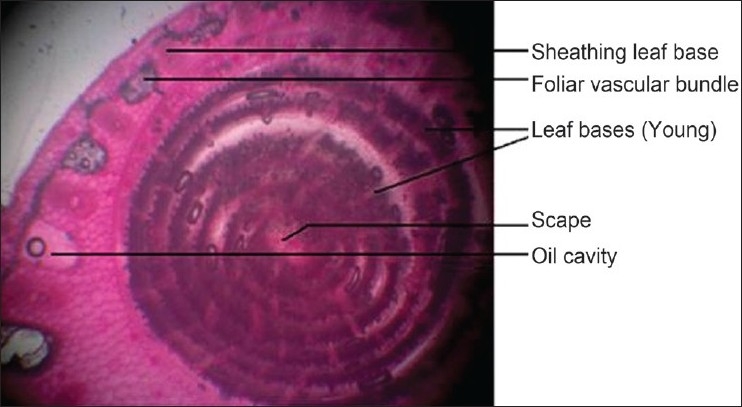
TS of rhizome epical part
Figure 9.
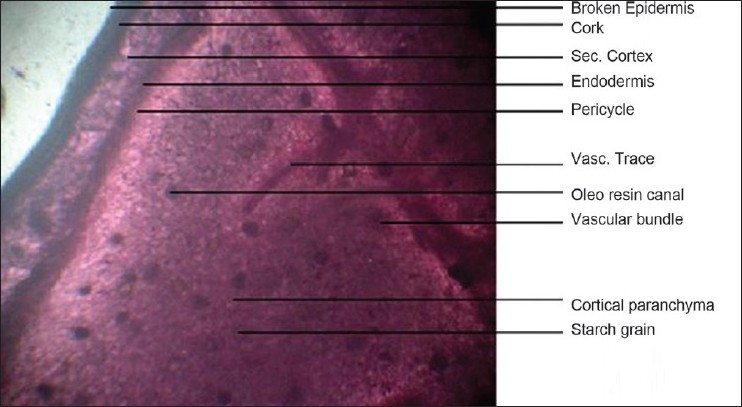
TS of Curcuma caesia rhizome
Epidermis – single layered composed of very thick wall cells, covered with thick cuticle
Cortex – three to five layered, thick walled collenchymatous cells
Endodermis – ill developed
Pericycle – well-defined cells radially and compactly placed
Pith – large parenchymatous, a large number of cells are filled either with starch grains or sphaeraphides, a number of vascular traces traverse in the pith may be leaf traces
Vascular tissue – vascular bundles are conjoint and scattered, xylem consists of vessels and xylem parenchyma. Phloem composed of sieve tubes phloem parenchyma
Leaf – the isobilateral leaf of plant shows [Figures 10 and 11]
Figure 10.
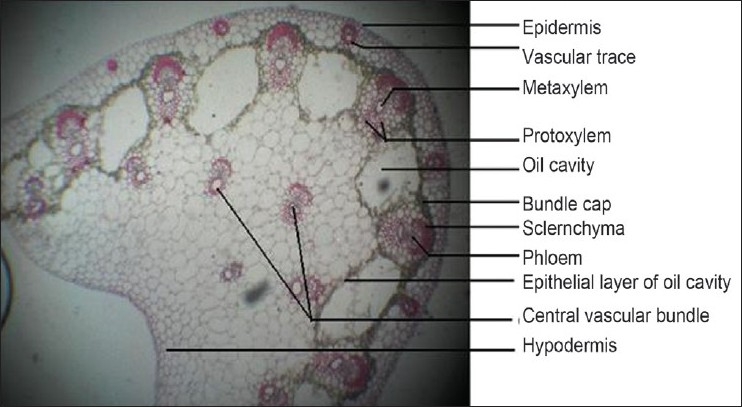
TS of central part of leaf
Figure 11.
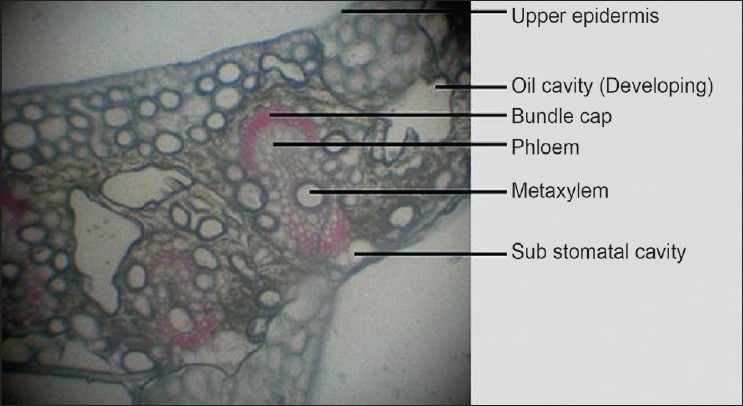
TS of leaf lamina
Epidermis – both upper and lower epidermis are identical, it is single and single layered covered with cuticle and perforated by stomatas
Mesophyll – palisade and spongy parenchyma not demarcated, they are intermixed in mesophyll, and entire mesophyll is chlorophyllens with scattered oil cavities. The wall of oil cavities is well defined and made up of epithelial cells
Vascular bundles – they are mixed with oil cavities, each bundle is conjoint and collateral with an arch of sclerenchyma over xylem
Powder Study of Rhizome
The powder is brownish black with camphoraceous odor. The taste is bitter; it includes powder fibers and small granules of vessels [Figures 12 and 13].
Figure 12.
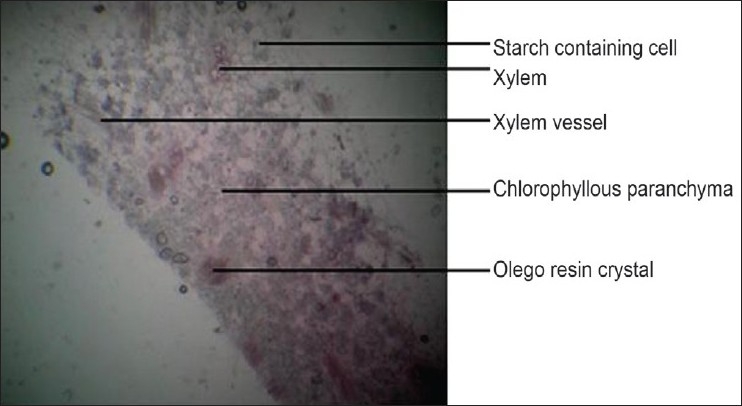
Powder and allied parts
Figure 13.
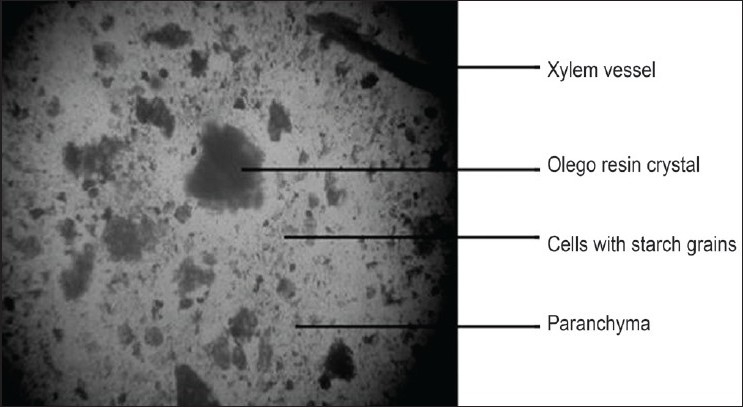
Curcuma caesia powder microscopy
-
a)
Parenchyma – spherical to angular cells in the forms of grains. The grains are clumps of parenchymatous cell; they are filled with starch grains, which become blue with iodine solution
-
b)
Oligorasin crystals – originally impregnated in parenchyma they become free in powder and are found in dispersed condition
-
c)
Vascular elements – large number of vessels elements either entire or in the form of fragments. They show spiral and pitted thickenings, most of the elements are of vessel category, and tracheids are few and occasional
Phytochemical Studies
Various physicochemical constants, such as moisture content, ash value, acid-insoluble ash, LOD, and water and alcohol soluble extractives were determined and the values are depicted in Figure 14 and Table 1. The percentages of successive Soxhlet solvent extractives were calculated and the results are depicted in Figure 15, and Table 2. Preliminary phytochemical studies showed the presence of alkaloids, steroids, phenolics, and tannins as the major constituents in the successive solvent extraction [Table 3].
Figure 14.
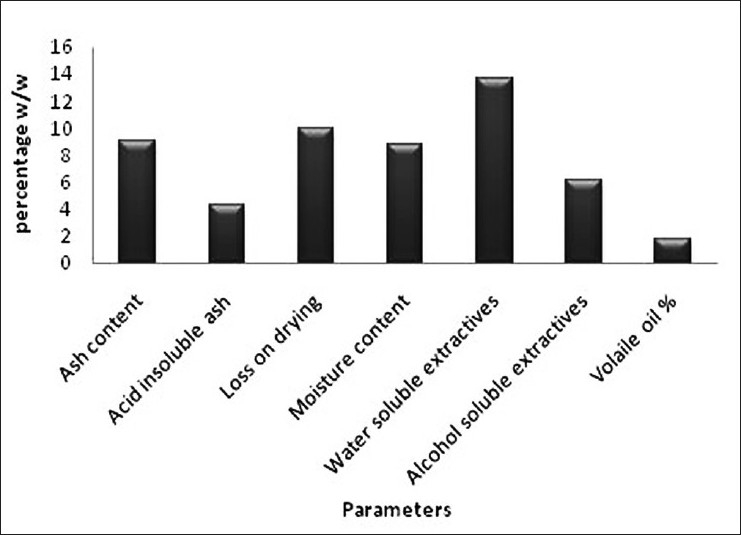
Physicochemical constants of Curcuma caesia rhizomes
Table 1.
Physicochemical constants of Curcuma caesia Roxb. rhizomes
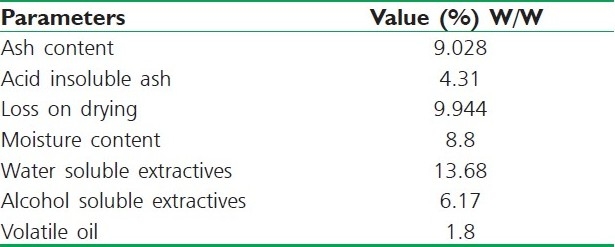
Figure 15.
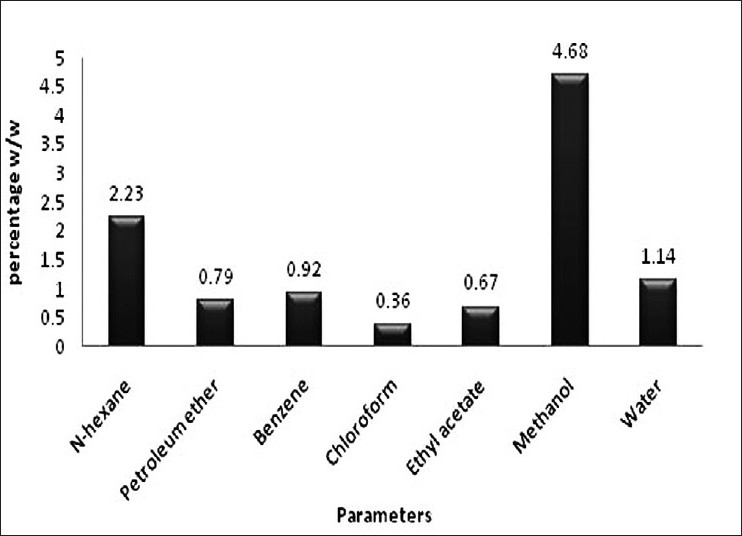
Successive extractive values of Curcuma caesia rhizomes
Table 2.
Successive extractive values of Curcuma caesia Roxb. rhizomes
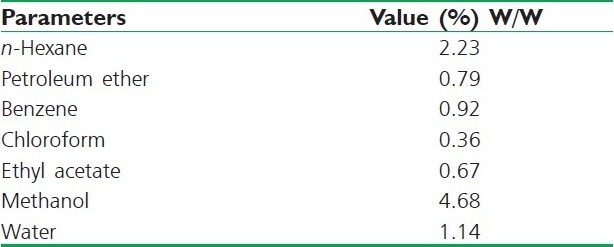
Table 3.
Phytochemical screening of Curcuma caesia Roxb. rhizome extracts

Thin Layer Chromatography
The thin layer chromatography study has revealed the presence of camphor in the extract and a band at (Rf 0.65) was visible in both test and standard solution [Figure 16; Table 4].
Figure 16.
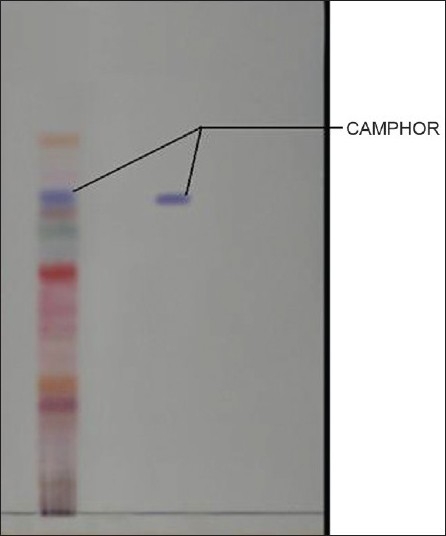
TLC of Curcuma caesia
Table 4.
TLC details of Curcuma caesia Roxb. rhizomes
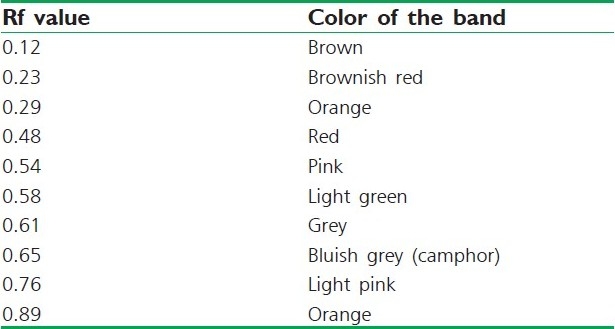
DISCUSSION
The gas chromatography-mass spectrometry analysis of the volatile oil of rhizomes shows that it contains 1,8-cineole (27%–48%), camphor (14%–28.3%) as major component,[15] as well as ar-turmeone (12.3%). The volatile oil of rhizomes ranges from 1.5% to 1.8%.[16] These are valuable information for identification of oil.
Very less information is available on the identification of C. caesia Roxb. Therefore, some diagnostic features have been evolved to identify and to differentiate the C. caesia rhizomes from other crude drugs and adulterants. The important microscopic and macroscopic features of the various parts of the plant have been documented along with TLC, physicochemical constants, and phytochemical screening, which can serve as a valuable source of information and provide suitable standards for identification of this plant material in future investigations and applications.
CONCLUSION
The genus Curcuma represents many species, most of them are fully explored but C. caesia Roxb. is not much studied. Traditional claims of this crude drug are yet to be pharmacologically explored to develop new compounds, which may be beneficial for future studies.
ACKNOWLEDGMENT
One of the authors Mr. Pritesh Paliwal would like to thank Professor S. R. Upadhyay and Dr. D. K. Jain of College of Pharmacy, I.P.S.Academy, Indore for providing technical assistance and facilities during the studies.
Footnotes
Source of Support: Nil
Conflict of Interest: Nil.
REFERENCES
- 1.Nadkarni KM. Indian Material Medica. Vol. 1. Bombay: Popular Prakashan; 1976. p. 414. [Google Scholar]
- 2.Anonymous, The wealth of India. Vol. 2. New Delhi: Council of Scientific and Industrial Research; 2001. p. 264. [Google Scholar]
- 3.Kirtikar KR, Basu RD. Indian Medicinal Plants. Dehradun: International book distributors; 1987. pp. 2418–26. [Google Scholar]
- 4.Vijay Chourasia. self medication of Baiga tribal's, Aayushman. 2006 Oct;:49. [Google Scholar]
- 5.Mannangatti K, Narayanasamy M. Anti-fungal protein from Curcuma caesia Roxb. J Biotechnol. 2008:S136–90. [Google Scholar]
- 6.Arulmozhi DK, Sridhar N, Veeranjaneyulu A, Arora SK. Preliminary mechanistic studies on the smooth muscle relaxant effect of hydro alcoholic extract of Curcuma caesia. J herb pharmacother. 2006;6:117–24. doi: 10.1080/j157v06n03_06. [DOI] [PubMed] [Google Scholar]
- 7.Khandelwal KR. Practical Pharmacognosy. 10th ed. Pune: Nirali Prakashan; 2003. p. 26. [Google Scholar]
- 8.Indian Pharmacopoeia. Vol. 2. New Delhi: Government of India; 1996. Anonymous; p. A53. [Google Scholar]
- 9.Kokate CK, Purohit AP, Gokhale SB. Textbook of pharmacognosy. Pune: Nirali Prakashan; 1999. p. 72. [Google Scholar]
- 10.Mukharjee P. Quality control of herbal drugs. New Delhi: Business Horizons; 2002. p. 246. [Google Scholar]
- 11.Gautam A, Jhade D, Ahirwar D, Sujane M, Sharma GN. Pharmacognostic evaluation of Toona Ciliata bark. J Adv Pharm Tech Res. 2010;1:216–20. [PMC free article] [PubMed] [Google Scholar]
- 12.Sethiya NK, Trivedi A, Patel MB, Mishra SH. Comparative pharmacognostical investigation on four ethanobotanicals traditionally used as Shankhpushpi in India. J Adv Pharm Tech Res. 2010;1:388–95. doi: 10.4103/0110-5558.76437. [DOI] [PMC free article] [PubMed] [Google Scholar]
- 13.Wagner H. Plant drug analysis. 2nd ed. New Delhi: Springer-India; 2007. p. 149. [Google Scholar]
- 14.Stahl E. Thin layer chromatography. New York: Springer-Verlag; 1969. p. 224. [Google Scholar]
- 15.Pandey AK, Chowdhary AR. Volatile constituents of rhizome oil of Curcuma caesia. Flavour Frag J. 2003;18:463–5. [Google Scholar]
- 16.Behura S, Srivastava VK. Essential oils of leaves of curcuma species. J Essent Oil Res. 2004;16:109. [Google Scholar]


